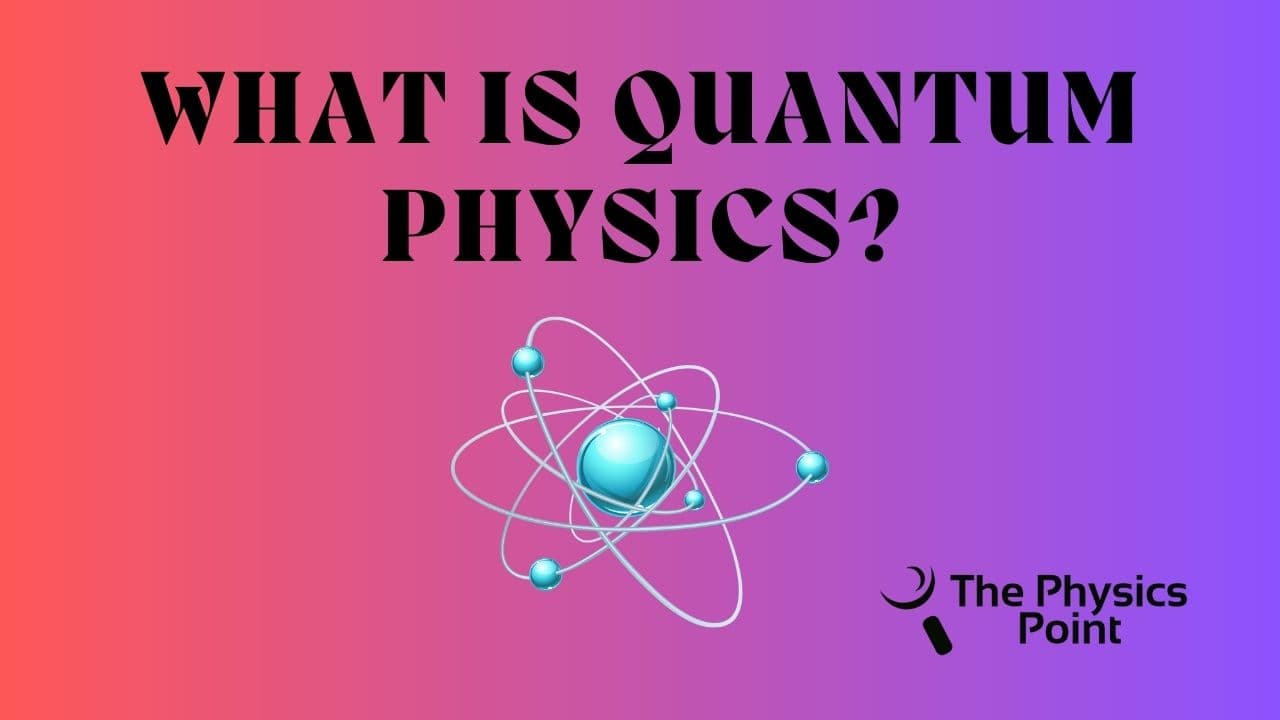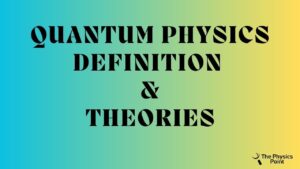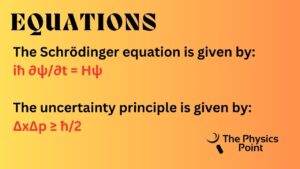What is Quantum Physics? Definition, Theory and Equations

Welcome to the super most imported article of Physics, what is quantum physics? In the article, we will explore the mind-blowing principles and concepts that describe the behavior of matter and energy at the atomic and subatomic levels also. Quantum mechanics created a revolution in our understanding of the universe by revealing the mysterious and suspicious nature of reality at the atomic as well as subatomic scale. There were many great scientists who contribute so much to exploring quantum mechanics these scientists are Max Planck, Niels Bohr, Albert Einstein, Erwin Schrödinger, and Werner Heisenberg. Nowadays, Quantum mechanics is one of the most well-known as well as well-established branches that give the best theories in Physics about atoms and subatomic particles.
Today in this most important article what is quantum physics we are going to describe some very important questions from the exam point of view. These questions are in the form of what is quantum theory, the study of quantum mechanics is related to the quantum physics meaning in Hindi, the definition of quantum physics, quantum mechanics definition, quantum physics definition, quantum physics scientists, what is quantum physics used for, quantum theory explained, etc. We again request you please read this article (What is Quantum Physics?) very carefully. So that the meaning of quantum physics is well understood by you.
What is Quantum Physics (Definition and Theories)?
Quantum physics is the Physics branch, in which the dual nature or behavior of a particle is described. This dual nature of a particle is described at the subatomic level and atomic level. There is another branch of Physics called classical physics that is unable to explain the dual nature of matter so quantum physics came to light in the 19th century. Classical physics is unable to describe also the uncertainty principle.
Quantum physics is also known as quantum mechanics. theory of quantum physics helps us to know the particle exists in a superposition of states unless they are measured at that collapse into a perfect state. So we can easily say that the particle does not have a definite momentum or position until they are in the observation and its nature cannot be predicted with correct certainty.
The calculations and mathematics of the quantum mechanics of quantum physics are totally based on the principle of linear Algebra and its functional analysis. Quantum Mechanics is expressed in the terms of wave functions. the way function helps us to find a particle in a particular state.

Equation
The main equation of this Quantum physics is the Schrödinger wave equation, which tells us about the time evolution of the wave function of a quantum system. The Schrödinger equation is given by:
iħ ∂ψ/∂t = Hψ
Here,
- ħ indicates the reduced Planck constant
- t is time
- ψ indicates the wave function of the associated system.
- H indicates the Hamiltonian operator, which is used to represent the overall energy of the associated system.
We can see here that the Schrödinger wave equation is a partial differential equation. The wave function tells us the chances of finding the system in a particular state and can be used to calculate observable properties of that system, such as its Momentum as well as energy.
There is another Equation in quantum physics on the account of the uncertainty principle. This equation is given by the scientist Heisenberg, so it is called the Heisenberg uncertainty principle. With the help of this equation, we can measure the position and momentum of a Quantum particle. The uncertainty principle is given by:
Δx.Δp ≥ ħ/2
Here,
- Δx is known as the uncertainty in the position of the particle.
- Δp is called the uncertainty in its momentum.
- ħ, which is pronounced as “h-bar” represents the reduced Planck constant.
The reduced Planck constant (ħ) which is pronounced as “h-bar”, is a physical constant. It has a value of approximately 1.054571817 × 10-34 joule.sec
It is related to the Planck constant h, by this equation:
ħ = h / 2π.

Application of Quantum Physics
The most essential branch of physics is quantum mechanics has vast applications in fields such as chemistry science, electronics, Material science, and many more. Quantum physics allowed to development of more advanced technology in the field of Electronics such as transistors, lasers, and Magnetic resonance imaging that is also known as MRI.
Quantum mechanics created a revolution in our understanding of the universe by revealing the mysterious and suspicious nature of reality at the atomic as well as subatomic scale. Principles of quantum physics have challenged our traditional views of causality and determinism, forcing us to think again about the fundamental laws that govern this universe.
Some Frequently Asked Questions (FAQs)
Ques. What is quantum physics?
Ans. Quantum physics is the physics branch, in which the dual nature or behavior of a particle is described. This dual nature of a particle is described at the subatomic level and atomic level. So this is the definition of What is Quantum Physics.
Ques. What is the meaning of dual behavior of any matter?
Ans. Physically matter seems to be a particle but dual behavior explains the matter in its two properties, which are two types of properties first of the particle nature and the other is the wave nature.
Ques. Which branch of Physics is not successful in explaining the dual nature of matter?
Ans. Classical physics was unable to understand the dual nature of matter.
Conclusion
So in today’s article, we have talked about many things related to what is quantum physics, and quantum theory. Some of the important questions were also discussed. These questions are What is Quantum Physics, quantum mechanics, quantum theory, quantum physics meaning, what is quantum mechanics, meaning of quantum physics, etc…So Any doubt related queries plz contact us through the comment box. We are always eager to give you a reply as soon as possible. Very soon we will again meet with a new physics article on our website. Thanks!
